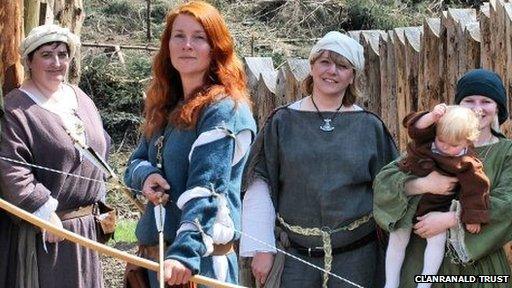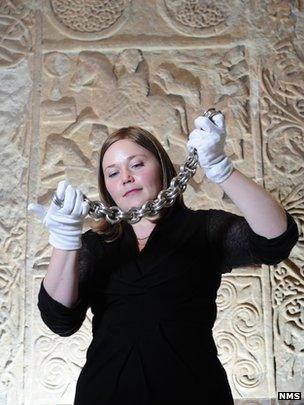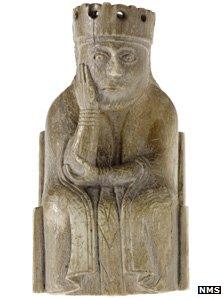Search for the real Merida of Disney Pixar's film Brave
- Published

Malin Heen-Allan, who believes Merida-like figures must have existed in Scotland's past, draws a bow watched by other members of Stirlingshire's Clanranald Trust
Brave is showing in Scottish cinemas and will be released across the rest of the UK from 13 August. But does Scotland's history provide us with any real-life versions of its lead character, Princess Merida?
Stoked with stories of her father's tussles with ferocious bears and bravery in battle, Merida seeks out her own adventures on horseback, armed with her trusty bow and arrow.
Her behaviour upsets her mother, the savvy Queen Elinor, who also fears her daughter's resistance to tradition - particularly marriage - will ignite a clan war.
Archaeologist Alice Blackwell, Glenmorangie research officer at National Museums Scotland in Edinburgh, said those behind Brave drew inspiration from real objects and sites from different periods of Scottish history.
She said: "Amongst the pieces they have used are the Lewis Chessmen, external, which also give us ideas about the role of women in the past.

Alice Blackwell with the Hilton of Cadboll Stone and a post-Roman silver chain
"There are eight queens for four chess sets that were probably made in the late 12th Century.
"Firstly, this tells us that queens were recognised as being important.
"They are wearing crowns and dressed in long robes and thick cloaks.
"Several hold drinking horns in their laps. These horns were prestigious and used for communal drinking.
"It is possible that the women in the society represented by the chess pieces played a kind of peace weaver role. They would travel around the men in the hall with the cup, allowing them in turn to drink from it."
A massive Pictish Christian monument, the Hilton of Cadboll Stone, external, may also give clues.
The stone has a figurative decoration showing a hunting scene with several male figures on horses and hunting dogs bringing down a deer.
There is a main figure at the top left, a person riding a horse sideways and facing outwards, towards the viewer, unlike all the others who are in profile
Recent research has suggested that the carving represents Jesus, or the Virgin Mary, as both have been portrayed elsewhere riding horses sideways.
However, there has been a long standing theory that the figure depicts a high ranking woman.
Alice said: "Traditionally, this figure has been identified as a woman and many people have assumed her to be a very important secular woman, perhaps a Pictish queen.
"The figure is shown with flowing hair. A lot of attention has been given to the hair, as if that was a very important thing to depict."
Other objects suggesting that high status was afforded to women include silver chains made to a size that mostly likely fitted the necks of women or adolescents.
Alice said: "Eleven chains are known to have been found and nine survive.
"They are very hard to date, but our best guess is that they are post-Roman, so probably 5th, 6th or 7th century AD.
"The heaviest surviving example is three kilograms of solid silver, so they were incredibly important high status objects."
Alice said ancient burials in Scotland, unlike those of other medieval societies such as the Anglo-Saxons, did not involve the laying of jewellery and weapons with the dead, making it harder to determine what a person's standing was in life.
'Snow-white horse'
Malin Heen-Allan, of the Clanranald Trust - who bears an uncanny resemblance to Brave's flame-haired female lead - believes gaps in the understanding of Scotland's past leaves a portcullis open to the chance that girls like Merida had lived.
Born in Norway, Malin grew up hearing stories of Viking women who managed farms and slaves while men were away fighting or claiming new territories.
After settling in Scotland 16 years ago, Malin has become fascinated with the ancient history of her adopted home.
She said: "What we know of history is based on finds and books, but what we dig up or what is written down does not represent everyone of those times.
"Take any group of 10 people and you will always have some who are extremely different from the others - people who think outside of the box.

The 12th Century Lewis Chessmen include eight queens
"Just because there is no documentation of them does not mean they did not exist."
A time packed with documented examples of leading ladies is the 18th Century.
South Uist-born Flora Macdonald helped Bonnie Prince Charlie to evade capture after the Battle of Culloden.
Years later she found herself caught up in the American Revolution.
With her husband, Allan Macdonald, she emigrated to North Carolina in 1774 to run a plantation.
The following year, war broke out between the British government and American colonists.
Macdonald's husband was an officer in the Loyalist forces fighting alongside the British against the Patriots, whose combatants included women such as Molly Pitcher and Deborah Sampson.
A story goes that Macdonald addressed a newly-raised unit of Highland Loyalists in Gaelic as they prepared for battle.
She spoke of the loyalty, bravery and sacrifices of Scots.
Deanna Kerrigan, a former outreach programmes supervisor at the North Carolina Museum of History, has written of the legend, external.
The historian said that after giving her speech, Macdonald "mounted her snow-white horse, bade her husband farewell, and returned to her plantation".
Unfortunately for the Macdonalds, the battle ended in defeat for the Loyalists.
'Romantic adventure'
Aberdeenshire-based author Maggie Craig believes other women of the 1700s showed Merida's spirit.
Craig researched Jacobite women for her book Damn Rebel Bitches.
They included Jenny Cameron of Glendessary, who led 300 men to Glenfinnan where Bonnie Prince Charlie raised his standard in August 1745.
Isobel Haldane of Ardshiel challenged her husband to follow the Jacobite cause, or stay at home and wear her apron while she led clansmen to battle.
And 22-year-old Lady Anne Mackintosh became known as Colonel Anne for her actions in the Jacobite rising of 1745-46.
Maggie said: "Anne's husband, who was much older than her, was on the government side with a commission as a captain in the Black Watch.
"He was away when Anne, who had different views from her husband, decided that she was going to raise the clans Mackintosh and Chattan for Bonnie Prince Charlie.
"The stories of how she did this are the stuff of romantic adventure.
"She went out on horseback wearing a tartan riding habit, lace at her throat, a fighting man's blue bonnet on her head and a brace of pistols at her waist.
"Anne raised 300 men for the prince's campaign."
Traditions around marriage is a key theme of Brave and a factor in pushing the film's characters towards war.
The break up of a real marriage was the cause of a vicious clan battle at Cairinish on North Uist back in 1601.
A member of the island's Clan MacDonald had divorced his wife, a MacLeod from the Isle of Harris.
The MacLeods were so insulted that they sent a raiding party to Uist. The raiders were slaughtered.
Interestingly, the Battle of Cairinish has been described as the last battle in the British Isles to have been fought with bow and arrow, external - Merida's weapon of choice.
So for history buffs in the film's audiences, Brave's princess may be a little more familiar figure than they might have expected.
- Published2 July 2012
- Published29 June 2012
- Published9 November 2011
- Published8 September 2011
- Published16 March 2011